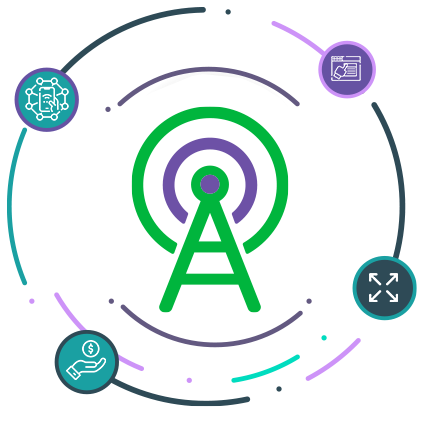You can always tell who the real telecom engineers are. They’re the ones
sipping cold coffee at 2 a.m., staring at dashboards like it’s the season
finale of a thriller series, eyes darting between blinking lights and packet
counts, whispering, “Don’t you dare time out on me.”
And when something does go wrong, they don’t panic, they squint at the screen, crack their knuckles, and dive into SIGTRAN traces like Sherlock Holmes solving a murder mystery in binary. That, my friend, is not chaos. That’s controlling the art of monitoring SIGTRAN traffic like a pro.
But here’s the kicker: most people think SIGTRAN is some complex telecom riddle wrapped in a protocol. In reality, it’s the invisible rhythm keeping your calls, texts, and network services perfectly in sync. And if you know how to monitor that rhythm, you’re not just an engineer, you’re basically the DJ of the telecom world.
So, let’s tune in to why every modern engineer needs to master this groove—and how the mighty SIGTRAN Gateway makes it all possible.
SIGTRAN stands for “Signaling Transport,” and it’s basically how your network whispers sweet nothings to itself the behind-the-scenes conversation that keeps calls, messages, and data sessions running smoothly. It’s the quiet hero, always on duty, never asking for credit.
Now imagine if that whisper suddenly became a mumble. You’d have dropped calls, delayed messages, confused subscribers, and a lot of very angry customer care agents. Monitoring SIGTRAN traffic is like learning to understand those whispers, catching the small hiccups before they turn into a full blown network tantrum.
And that’s where the SIGTRAN Gateway comes in—your trusty interpreter between the traditional SS7 world and the newer IP-based world. It’s like a multilingual translator that never sleeps, ensuring all those network messages stay in sync, in time, and in order.
Back in the day, telecom networks were simpler. Engineers could walk into the server room, tap a blinking light, and feel like heroes. But today, networks are like bustling cities—interconnected, fast-moving, and full of hidden traffic jams.
Monitoring SIGTRAN traffic is like having traffic cameras at every intersection. Without it, you’re just hoping no one’s crashed at 4 AM in the data lane. And let’s face it, “hope” isn’t exactly a solid network strategy.
The SIGTRAN Gatewayives you visibility into that chaos. It helps you see patterns, detect anomalies, and prevent the kind of “mystery issues” that make managers hover around your desk asking, “So… when will it be fixed?” (because that’s always helpful).
You know that feeling when your favorite app suddenly stops working, and you panic refresh it like your life depends on it? That’s what happens on a bigger scale in telecom when SIGTRAN traffic goes rogue.
By monitoring it, you’re not just reacting—you’re predicting. You become the weather forecaster of your network, spotting the “storm clouds” of congestion or failed links before they cause an outage.
And when your colleagues ask how you fixed the problem so fast, you can just smile mysteriously and say, “I have my ways.” (They don’t need to know it’s all thanks to that SIGTRAN Gateway quietly doing its magic.)
Let’s put it this way: a single minute of network downtime can cost a telecom operator thousands of dollars—not to mention a tidal wave of tweets from angry users. So every second you save by spotting a SIGTRAN issue early is money in the bank (and one less 3 AM panic call for you).
A well-monitored SIGTRAN Gateway helps you cut those costs by automating alerts, reducing downtime, and keeping your systems humming like a perfectly tuned orchestra. Instead of manually poking around logs for hours, you get actionable insights—clear, fast, and accurate.
You’ll spend less time firefighting and more time doing what you actually enjoy, like fine tuning systems, planning upgrades, or finally taking that coffee break you’ve been postponing since Monday.
Here’s the thing: engineers who can interpret SIGTRAN traffic are rare gems. It’s a mix of technical intuition and pure detective work, and that combo makes you invaluable. You’re not just fixing things—you’re preventing disasters before they even happen.
When your SIGTRAN Gateway is running smoothly and you’ve got monitoring nailed down, it feels like magic. Calls connect faster, data sessions stay stable, and your manager might even remember to say “great job!” (We can dream.)
Plus, once you’ve mastered it, you start seeing the bigger picture. You understand how every message, transaction, and heartbeat of your network fits together—like finally seeing the whole jigsaw puzzle instead of random pieces.
Monitoring doesn’t have to be boring. Think of it like watching a live action thriller, except instead of car chases, it’s packet flows, and instead of explosions, it’s sudden bursts of traffic that you get to tame like a pro.
You can even gamify it: challenge your teammates to spot anomalies first, predict peak usage times, or identify the weirdest traffic patterns. It keeps the work exciting—and who doesn’t love a little friendly competition over coffee and command lines?
In the fast-moving telecom world, staying ahead means staying aware, and monitoring SIGTRAN traffic is how you do that. It’s not just a technical skill; it’s your secret weapon, your stress saver, and your ticket to becoming the go-to problem solver in your team.
So the next time you log into your dashboard and see that smooth flow of packets, take a moment to appreciate it. That’s your hard work (and your SIGTRAN Gateway) keeping the world connected—one perfectly timed signal at a time.
And if you’re ready to take your SIGTRAN game to the next level, check out hSenid Mobile’s SIGTRAN Gateway a flexible, customizable solution built for engineers who want reliability without the complexity.
Because when it comes to networks, calm is the new cool and you’re the one making it happen.
And when something does go wrong, they don’t panic, they squint at the screen, crack their knuckles, and dive into SIGTRAN traces like Sherlock Holmes solving a murder mystery in binary. That, my friend, is not chaos. That’s controlling the art of monitoring SIGTRAN traffic like a pro.
But here’s the kicker: most people think SIGTRAN is some complex telecom riddle wrapped in a protocol. In reality, it’s the invisible rhythm keeping your calls, texts, and network services perfectly in sync. And if you know how to monitor that rhythm, you’re not just an engineer, you’re basically the DJ of the telecom world.
So, let’s tune in to why every modern engineer needs to master this groove—and how the mighty SIGTRAN Gateway makes it all possible.
The Mystery Behind the Packets
SIGTRAN stands for “Signaling Transport,” and it’s basically how your network whispers sweet nothings to itself the behind-the-scenes conversation that keeps calls, messages, and data sessions running smoothly. It’s the quiet hero, always on duty, never asking for credit.
Now imagine if that whisper suddenly became a mumble. You’d have dropped calls, delayed messages, confused subscribers, and a lot of very angry customer care agents. Monitoring SIGTRAN traffic is like learning to understand those whispers, catching the small hiccups before they turn into a full blown network tantrum.
And that’s where the SIGTRAN Gateway comes in—your trusty interpreter between the traditional SS7 world and the newer IP-based world. It’s like a multilingual translator that never sleeps, ensuring all those network messages stay in sync, in time, and in order.
Why Monitoring Isn’t Optional (Anymore)
Back in the day, telecom networks were simpler. Engineers could walk into the server room, tap a blinking light, and feel like heroes. But today, networks are like bustling cities—interconnected, fast-moving, and full of hidden traffic jams.
Monitoring SIGTRAN traffic is like having traffic cameras at every intersection. Without it, you’re just hoping no one’s crashed at 4 AM in the data lane. And let’s face it, “hope” isn’t exactly a solid network strategy.
The SIGTRAN Gatewayives you visibility into that chaos. It helps you see patterns, detect anomalies, and prevent the kind of “mystery issues” that make managers hover around your desk asking, “So… when will it be fixed?” (because that’s always helpful).
The Art of Spotting Trouble Before It Strikes
You know that feeling when your favorite app suddenly stops working, and you panic refresh it like your life depends on it? That’s what happens on a bigger scale in telecom when SIGTRAN traffic goes rogue.
By monitoring it, you’re not just reacting—you’re predicting. You become the weather forecaster of your network, spotting the “storm clouds” of congestion or failed links before they cause an outage.
And when your colleagues ask how you fixed the problem so fast, you can just smile mysteriously and say, “I have my ways.” (They don’t need to know it’s all thanks to that SIGTRAN Gateway quietly doing its magic.)
Monitoring = Money (And Sanity) Saved
Let’s put it this way: a single minute of network downtime can cost a telecom operator thousands of dollars—not to mention a tidal wave of tweets from angry users. So every second you save by spotting a SIGTRAN issue early is money in the bank (and one less 3 AM panic call for you).
A well-monitored SIGTRAN Gateway helps you cut those costs by automating alerts, reducing downtime, and keeping your systems humming like a perfectly tuned orchestra. Instead of manually poking around logs for hours, you get actionable insights—clear, fast, and accurate.
You’ll spend less time firefighting and more time doing what you actually enjoy, like fine tuning systems, planning upgrades, or finally taking that coffee break you’ve been postponing since Monday.
From Chaos to Control, The Engineer’s Glow-Up
Here’s the thing: engineers who can interpret SIGTRAN traffic are rare gems. It’s a mix of technical intuition and pure detective work, and that combo makes you invaluable. You’re not just fixing things—you’re preventing disasters before they even happen.
When your SIGTRAN Gateway is running smoothly and you’ve got monitoring nailed down, it feels like magic. Calls connect faster, data sessions stay stable, and your manager might even remember to say “great job!” (We can dream.)
Plus, once you’ve mastered it, you start seeing the bigger picture. You understand how every message, transaction, and heartbeat of your network fits together—like finally seeing the whole jigsaw puzzle instead of random pieces.
Making It Fun (Yes, Really)
Monitoring doesn’t have to be boring. Think of it like watching a live action thriller, except instead of car chases, it’s packet flows, and instead of explosions, it’s sudden bursts of traffic that you get to tame like a pro.
You can even gamify it: challenge your teammates to spot anomalies first, predict peak usage times, or identify the weirdest traffic patterns. It keeps the work exciting—and who doesn’t love a little friendly competition over coffee and command lines?
Wrapping It Up
In the fast-moving telecom world, staying ahead means staying aware, and monitoring SIGTRAN traffic is how you do that. It’s not just a technical skill; it’s your secret weapon, your stress saver, and your ticket to becoming the go-to problem solver in your team.
So the next time you log into your dashboard and see that smooth flow of packets, take a moment to appreciate it. That’s your hard work (and your SIGTRAN Gateway) keeping the world connected—one perfectly timed signal at a time.
And if you’re ready to take your SIGTRAN game to the next level, check out hSenid Mobile’s SIGTRAN Gateway a flexible, customizable solution built for engineers who want reliability without the complexity.
Because when it comes to networks, calm is the new cool and you’re the one making it happen.








